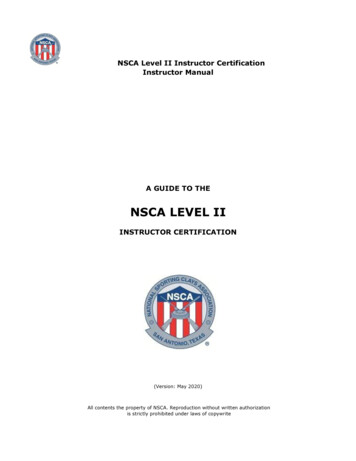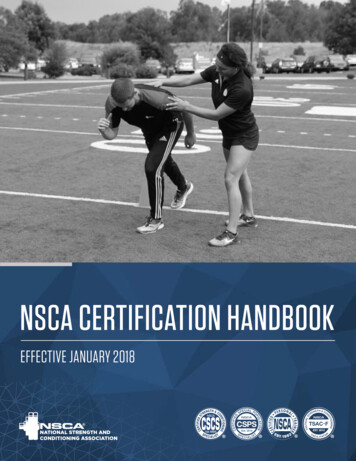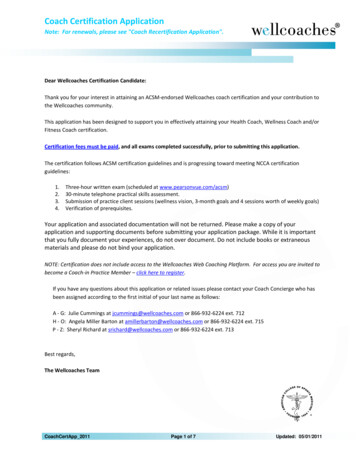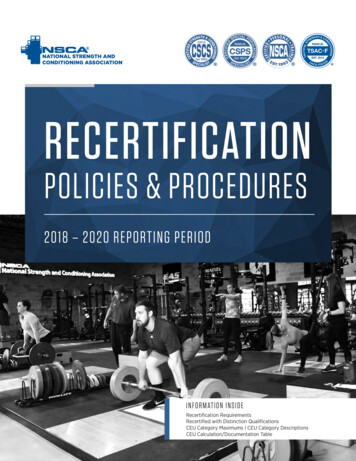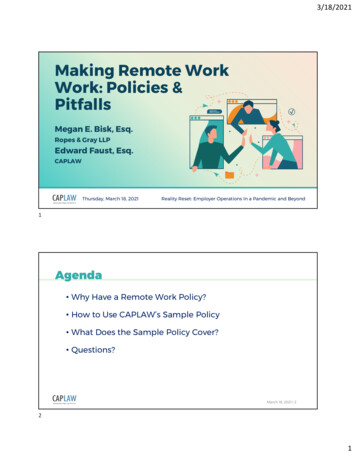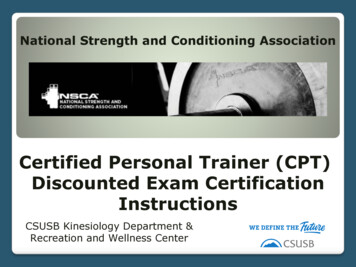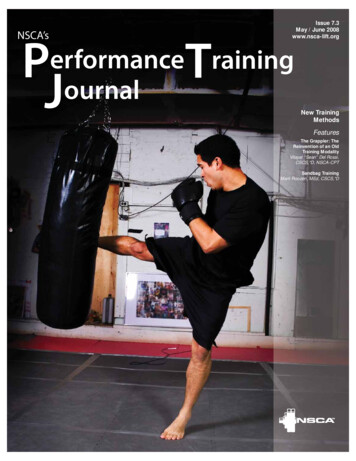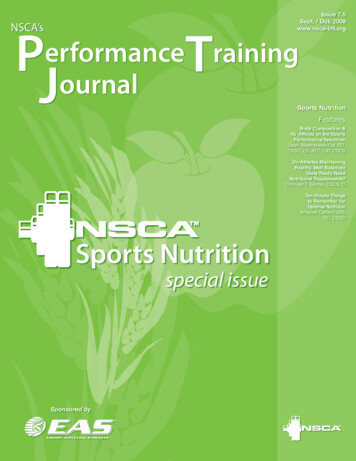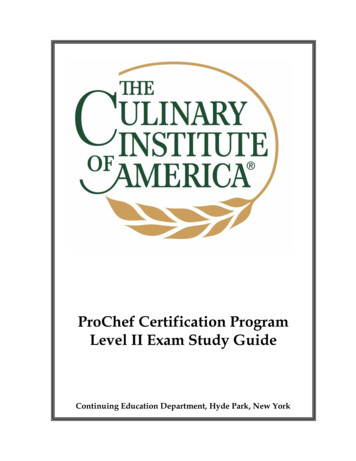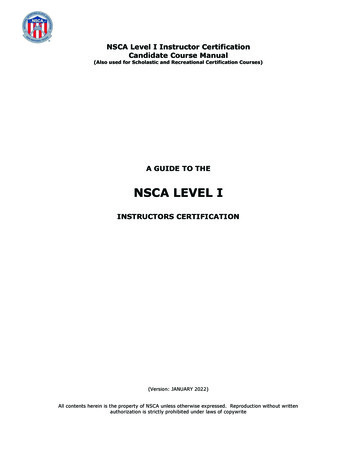
Transcription
NSCA Level I Instructor CertificationCandidate Course Manual(Also used for Scholastic and Recreational Certification Courses)A GUIDE TO THENSCA LEVEL IINSTRUCTORS CERTIFICATION(Version: JANUARY 2022)All contents herein is the property of NSCA unless otherwise expressed. Reproduction without writtenauthorization is strictly prohibited under laws of copywrite
Table of ContentsI. Welcome Letter3II. Mission, Purpose and Acknowledgments4III. Adjunct Certifications5IV. Admissions Guidelines, Criteria and Cost6V. NSCA Philosophy of Instruction7VI. Required Competencies1st.9Safety & Positive Control92nd. Assess Eye Dominance133rd. Assess Gun Fit194th. Teach the Fundamentals235th. Understanding Lead and Lead types296th. Problem Solving - “Getting the student to hit the target.”35i. Identifying the placement of a missii. Identifying the cause or reason for a miss37387th. Observation, Motivation and Communication40VII. Other topics43A. Reading the Targets43B. Beginner Targets and Shooter Ability44C. Chokes and Loads45D. Lesson Plan46E. Marketing47VIII. Post Graduation472Version: Jan 2022NSCA Level I Certification Manual 2022 – NSCA
Dear Instructor Candidate:On behalf of the Instructor Committee and the staff of the NSCA, welcome tothe NSCA Level I Instructor Certification Course. This 3-day course is widelyrecognized as the finest course in North America for training shotgunninginstructors. This is why over 200 shotgun enthusiasts annually, from acrossthe country and many from around the world, seek the experience andknowledge imparted by certifying instructors in one or more of the NSCA’sinstructor courses. With that said, there is always room for improvement sowe invite your comments on ways in which we can improve the course andprogram.We hope this Level I Course will serve as a great start for your journey ofintroducing shooters to Sporting Clays and helping them improve theirproficiency. In accepting your application to attend the Level I course, weexpect that you are already familiar with the fundamentals of shotgunning.Building on your shotgunning experience, the Level I course is designed totrain you how to teach novice and beginning students the fundamentals ofsuccess in breaking clay targets as well as being a more successfulwingshooter.Thank you for taking this first major step in becoming a NSCA CertifiedInstructor and joining the many instructor candidates who preceded you inbringing countless new shooters into our great sport.Sincerely,Chief InstructorNational Sporting Clays AssociationNSCA Level III Instructor3Version: Jan 2022NSCA Level I Certification Manual 2022 – NSCA
II. Mission and PurposeMission StatementThe NSCA will deliver the most consistent and highest possible quality of instruction tosporting clays and FITASC shooters at all levels of shooting proficiency by training,maintaining and supporting a highly competent instructor corps and delivering the mosteffective curriculum possible, stressing safety and the fundamentals of good shotgunning.Purpose of the Level I Course and Certification: To produce and cer t i f y instructorswho can saf el y instruct beginning, novice and recreational shooters up to entry-levelcompetitors in sporting clays and FITASC. Level I Instructors are encouraged to be activecompetitors, will encourage their students to compete in the sport and promote the sportto new shooters. The Level I instructor should be a good communicator, proficient atteaching the fundamentals of shotgunning, assessing and addressing eye dominanceand basic gun fit issues as well as calling a miss. While the Level I graduate is notexpected to be a proficient diagnostician, the candidate is expected to show some aptitudefor diagnosing the causes of a miss on targets of basic to intermediate levels of difficulty.Additionally, the Level I program will encourage certified instructors to continue theirlearning process through teaching, shooting, individual study and seeking the assistanceand advice of one or more instructor mentors. Successful completion of this course to theLevel I standards will entitle the graduate to advertise as a Certified Level I NSCA Instructorand seek clients for instructional services.Acknowledgements:For as long as the NSCA’s Instructor Program has been in existence, many have contributedto the information now contained in the program’s manuals, not to mention the way inwhich the courses are now conducted. The course manuals have the flavor of manycontributors sprinkled about its pages. We extend our thanks to NSCA instructors such asVance Barnes, Peter and Wendy Crabtree, Gary Greenway, Mike Mc Alpine, RalphWiningham, Don Currie and many others who, over the years, have had a hand in thedevelopment of the NSCA Instructor Program.4Version: Jan 2022NSCA Level I Certification Manual 2022 – NSCA
III. Adjunct CertificationsAs our sport continues to mature, the NSCA has felt a strong need to maintain and evenenhance the prerequisite requirements, graduation standards and consistency of our Level ICourse. At the same time, we have seen an increasing demand for the Level I InstructorCourse content from youth and recreational circles. NSCA remains deeply committed tobeing an important source of training for volunteer instructors involved in youth programsyet we also recognize that, in the interest of time and perhaps money, many volunteershave not had the opportunity to engage in much clay target shooting. We are also seeing anincreasing number of resorts offering sporting clays on property, increasing demand forqualified “ambassadors” to introduce patrons to the sport.The NSCA has developed two adjunct certifications to the Level I Course to answer the needof those desiring the experience of a highly professional shotgun instructor’s course yet lacksome of the shooting experience normally required of Level I Course candidates. The NSCARecreational Instructor and NSCA Scholastic Instructor Courses provide the same course,curriculum content and rigor as the standard Level I instructor Course, but do not requirethe same level of shooting proficiency or performance standards for certification. Thosecandidates considering the Scholastic or Recreational Certification are encouraged to attendthe 3-day Level I Course if they feel they might be able to pass the shooter proficiencystandards or if they believe they might, at some point, want to pursue the Level Icertification. Certified Scholastic and Recreational Instructors are still required to attend theLevel I Certification Course in order to receive the Level I Certification. Please contact theChief Instructor to discuss your individual situation should you have any questions in thisregard.Scholastic Instructor CertificationThe purpose of the Scholastic Instructor Certification is to equip those coaching in youthshooting programs with the knowledge necessary to orient a youth shooter to shotgunningin a safe and entertaining manner. Often, the biggest challenge for youth shootingprograms is the availability of trained volunteer coaches. It is not the NSCAs intent to implythat youth shooting programs require less proficient coaches than adult students, however,with the shortage of Level I Certified volunteers and the scarcity of available time forvolunteer coaches to attend training courses, the Association felt it was critical to offer apath whereby volunteers could access the same information to assist them in coachingyouth shooters; after all, the youth shooter is the future of our sport.Recreational Instructor CertificationThe purpose of the Recreational Instructor Certification is to equip those engaged in arecreational or resort setting with the knowledge necessary to orient a beginner toshotgunning in a safe and entertaining manner.5Version: Jan 2022NSCA Level I Certification Manual 2022 – NSCA
IV. Admissions Guidelines, Criteria and Cost1. Applicants must be active members in good standing of NSCA.2. Applicants should be eighteen (18) years of age and have at least two (2) years ofshooting experience.3. Candidates are expected to be comfortable working with shooting students in a oneon-one situation and have a desire to function in the role of teacher. Candidates musthave the ability to empathize with their students. Previous teaching experience (e.g.,Boy Scouts, 4H Leader, sports coaching) is helpful but not required.4. Candidates must demonstrate a complete knowledge of and comply with shootingrange safety protocols. Only a 100% safe shooting environment will be acceptable.Candidates are solely responsible for their personal safety, the safety of their studentsand the safety of range personnel. Attention to every detail is essential.5. § Candidates must have taken a minimum of 2 hours of lessons from a Level I, II, IIIor equivalent instructor before the course.6. § Shooting Proficiency Requirement – Each candidate must prove reasonableproficiency at engaging clay targets with a shotgun by either, 1) having at one timeearned a minimum of an NSCA C Class rating and shot a minimum of 3,000 lifetimeregistered targets, OR 2) during the course, pass a Shooting Proficiency Test. By theend of the course, a Level I Candidate will demonstrate the ability to break more than70% of targets presented from four cardinal directions: 1) a target that comes fromsome distance away and is thrown directly toward the shooter and stalls or starts todescend at a point above the horizon and inside of thirty yards of the shooter’sposition (i.e., incoming target); 2) a target that originates near the shooter (within 15yards) and flies directly away from the shooter (i.e., outgoing target); 3) and 4) twotargets that come from some distance away and passing by perpendicular to theshooter at 20-25 yards similar to a skeet low-house target and a skeet high-housetarget shot from just behind position #4. The recommended proficiency test consistsof 20 targets, half of the targets being two crossing targets (for example, 5 pairs ofcrossing targets shot from just behind skeet station #4 with high-house and low houseon report) and half of them being incoming/outgoing targets (for example, 5 pairs ofincoming/outgoing targets shot from skeet stations 1 or 7 with high-house and lowhouse on report). Note: Certifying instructors are encouraged to use this segment ofthe class to also coach candidates who are observing to call a miss.§ Applicants for the Scholastic Instructor and Recreational Instructor Certifications are exempt from the indicatedrequirementsCOSTTuition is 600 for the three-day course plus shells, target costs and instructor expenses.Instructor expenses will vary with the distance the instructor is required to travel for thecourse as well as overnight stays required. This cost is divided equally among the instructorcandidates that attend the class. Additionally, the candidates will be required to pay for anytargets they personally shoot.At the discretion of the Chief Instructor, courses made up exclusively of candidatesattempting to achieve the Scholastic Instructor or Recreational Instructor Certifications maybe shortened to two days in length and reduced in price to 400.00 per person.6Version: Jan 2022NSCA Level I Certification Manual 2022 – NSCA
V. THE NSCA PHILOSOPHY OF INSTRUCTIONVirtually every individual learns at an improved rate and retains more of what is beingtaught through hands-on and interactive learning. “Telling” simply is not an efficient,effective teaching method. This model of hands-on and interactive learning is used in both“Training the Trainer” (teaching the instructor candidate) as well as a guide for instructorsand candidates to teach their students.The four major styles of learning are as follows with the first three being the ones you willmost commonly employ during your instructional sessions:Kinesthetic - Learn by FeelingVisual - Learn by ObservingAuditory - Learn by ListeningVisual Cognitive – Learn by ReadingMost individuals have a “preferred” learning style as well as secondary styles by which theylearn. It is the instructor’s job to identify the student’s preferred learning styles and usethis information to convey concepts using the method or methods most preferred by thestudent. A large majority of individuals learn best by repetitive activity or kinestheticlearning. This method is particularly useful in teaching and learning situations where skillsneed to be learned through personal trial and error. Another group of learners are beststimulated by visually observing (visual learners). Still a third, but relatively small group,learns most effectively by listening (auditory). A fourth and certainly very small group,learns best by reading (visual cognitive modality). The student’s preferred learning stylemay NOT be the one that is most comfortable or easiest for the instructor. For this reasonand the fact that students seeking shooting instruction are a diverse group, a highlyeffective instructor must be competent in utilizing all of these areas.To illustrate the application of the top three styles of learning, let’s use a scenario where aninstructor is teaching a student about the Break Point, Hold Point and Visual Pick-up Pointfor a particular target. A Visual student will be most receptive to the instructor pointing to avisual reference for the Break Point, Hold Point and Visual Pick-up Point. An Auditorystudent will want to hear the activity described and will want to be told where the BreakPoint, Hold Point and Visual Pick-up Points are. A Kinesthetic student will want to feelwhere the Break Point, Hold Point and Visual Pick-up Points are. With an empty gun, theinstructor may want to have the student mount the gun while he/she physically moves thefront of the gun for the student to the Break Point, Hold and Visual Pick-up Point bygrasping the forearm of the shotgun in front of the student’s front hand.To complement the preferred styles of learning, there are some basic teaching styles orteaching types available to you as the instructor to communicate new concepts to students.From an educational standpoint there are a number of known approaches to teaching. Hereare some of the ones you might try:A.B.C.7Socratic - uses questions to perk the student’s interest. “What’s your plan forthis target pair?”Discovery learning - where the instructor arranges target presentations sothat the student finds their own answers. (E.g., Take them to anew station and just have them shoot it.)Communicative - uses conversation as a means of training. “What is yournext goal in Sporting Clays”Version: Jan 2022NSCA Level I Certification Manual 2022 – NSCA
D.E.F.G.Observational learning – (visual, demonstrative) Show a student what to do.“Look at my foot position – my stance”Verbal – Describe what is to be done.“We are going to break this target at a different break point”Psycho-motor – is the basis of our training. These are physical skills driven bythe mental process.Repetitive - entrenches learned processes.“Great Job - Do It Again – Just Like That”All of these methods work well but not all of these methods work for each student. You, asthe instructor, must decide which technique fits each student. Remember, the mosteffective means to learn a skill is repetition.You, the instructor candidate, will have ample time to practice the NSCAteaching model. As you will see, much of the art and science of teaching is learning to askquestions of your students in order to find the correct teaching tool. Simply telling astudent what you see will usually not result in effective learning. Learning to shoot ashotgun well is best accomplished when a student and instructor learn to communicate andcooperate to solve each problem.Effective communication also often requires creativity. As an example, and to fostercreativity in your teaching methods, you may be asked to instruct a student without talking.Silent communication of an instructional concept may not be as difficult as one might thinkand may be as simple as moving a student’s gun, while in the ready position, to the correcthold point.8Version: Jan 2022NSCA Level I Certification Manual 2022 – NSCA
VI. REQUIRED COMPETENTCIESUnless otherwise noted below, each Level I Candidate is required to demonstratecompetency in a variety of tasks across seven competency areas in order to pass the courseas well as pass a course examination with a minimum score of 80%. The following tasksmust be performed on a pass/fail basis to the standard(s) and under the conditionsindicated for each task below. In an effort to get the Candidate to master each of the tasksrequired, the Certifying Instructor (“CI”) will provide any and all reasonable assistance toeach Candidate during the course. Discussion is provided for each competency area belowto provide context and background.COMPETENCY #1: Safety And Positive ControlTask #1-1: Individual Safety ResponsibilityCandidate will, at all times, demonstrate the proper knowledge of safety procedures that arean individual shooter’s responsibility while at the range to include:A. Primary Rules of Gun SafetyB. Proper range safety and etiquetteC. Proper wearing of hearing and eye protectionD. Responding appropriately to firearm and ammunition malfunctionsE. Recognizing potential safety hazardsCondition:In an instructional environment at a sporting clays range with one or more students underhis/her control.Standard:1) Candidate will achieve 100% compliance with all the primary safety rules (below) andensure that the student(s) does the same during the Candidate’s instructional sessionwith the student.2) Candidate will properly install and use, as well as insist that the student(s) and anyspectators properly use, eye and ear protection while on the range.3) Candidate will demonstrate proper etiquette and range safety procedures at all times toinclude responding appropriately to firearm and ammunition malfunctions andrecognizing potential safety hazards.Task #1-2: Safety & Positive ControlCandidate will demonstrate the ability to maintain positive control of their student and theirstudent’s firearm as well as maintain a safe instructional environment during all instructionalsessions.Condition: In an instructional environment at a sporting clays range with one or morestudents under their control.Standard:1) Candidate will deliver a safety briefing to every student at the beginning of a lesson.2) Candidate will demonstrate safe operation of firearms.3) Candidate will be in the proper position to control each student’s firearm andammunition at all times by:a. Positioning himself/herself in the proper location in relationship to thestudent: Within arm’s reach or less and immediately behind and to the rightof a right-handed shooter, or, within arm’s reach or less and immediatelybehind and to the left of a left-handed shooter, whether in or outside of ashooting stand.9Version: Jan 2022NSCA Level I Certification Manual 2022 – NSCA
b. Personally controlling ammunition.4) Candidate will continue to discuss safety, as appropriate, throughout the lesson.5) Candidate will ensure that student is 100% compliant with all safety rules and thatthe student operates firearms safely during the instructional session.6) Candidate will insure the proper use of hearing and eye protection throughout thecourse.Discussion:Safety is of paramount concern to everyone involved in the shooting sports. One laxmoment and disaster is likely to strike. This is especially true during an instructionalsession wherein the student is dividing concentration between listening to you andattempting to break targets and you are dividing your attention between observing thestudent, observing the targets, diagnosing the shooter’s problems, loading the gun andreleasing the targets. That division of concentration alone, even with an experiencedshooter and instructor, can be the basis for a safety problem. Given the higher safety risksinherent in an instructional session, you, the instructor, are responsible for the safe conductof the session and must assume a posture of “hyper-awareness” in order to prevent safetyviolations and avoid a potentially life-altering accident. This involves strict personalcompliance with primary safety rules (below) as well as maintaining positive control of yourstudent or group and the instructional session as a whole. Nothing less than 100%awareness and 100% compliance is required.Individual Safety ResponsibilityInstructors, during the course of an instructional session, have a higher level ofresponsibility for insuring a safe environment for themselves, their students, other patrons,shooters and range personnel. In addition to their personal compliance, instructors mustensure that the students under their care are 100% compliant as well. As an instructor on asporting clays range, patrons and range staff will look to you to set an example and, onoccasion, request your assistance. This is a lot of responsibility. You must remain vigilantand maintain a posture of “hyper-awareness”; guaranteeing safety for all concerned while atthe same time adding value to the student.The primary rules of gun, range and instructor safety are as follows:A.Always keep firearm pointed in a safe direction.B.Always keep finger off the trigger until target is called for.C. Always keep gun unloaded until ready to engage targets.D. Treat every gun as if it were loaded. Visually inspect chamber and barrelfor obstructions.E. Never mix shot shell ammo gaugesNote: Instructors will control ammo while teaching beginners (and atall times during the Level I Course).F. Whenever possible, students should shoot from inside a stand or cage.G. The action of a shotgun is to be kept open when it is in hand and studentis not in the shooting stand. Actions may be closed on Over/Undershotguns when they are in a gun rack. Auto and pump actions should bekept open.10Version: Jan 2022NSCA Level I Certification Manual 2022 – NSCA
H.Gun carry: Over/Under shotguns should be carried with the action openin one of two ways: 1) with the barrels facing downward/forward andaction resting on the shooter’s forearm and at the side of the shooter, 2)with barrels facing downward/forward and action resting on theshoulder of the shooter. Semi-automatic shotguns should be carried“military style” with the action open, butt of the gun in the shooter’shand and barrel pointing skyward and resting on the shooter’s shoulder.The action should face forward, away from the shooter, such thatanyone in front of the shooter can see that the action is open. Whenmoving a gun to or from the carry position to a gun rack or otherlocation, the shooter should use care not to “sweep” bystanders or pointthe shotgun in an unsafe manner.I. Instructor must stay within arms reach of the student. This proximity isparticularly important if the instructor is working outside a cage orshooting stand.J. Eye and ear protection are mandatory: Instructors will utilize and insistthat their students and nearby spectators properly utilize hearing andeye protection.Every instructor should have a safety plan. This amounts to a mental notebook regardingwhat to do in each shooting situation. Instructors should be well versed in the methods ofcontrolling a student’s gun movement. Always inspect a student’s firearm prior to beginningthe shooting part of the lesson. Some students will come to a lesson with either a borrowedgun or perhaps one that has been in storage for some time. A quick inspection of thestudent’s firearm during your initial encounter is essential. “Ole Betsy could have a chargein her.” Additionally, the gun barrel/chamber should be inspected in the event of anunusual report (noise) to ensure that the barrel is free from obstruction or blockage.Talk with the student regarding the primary rules of gun safety . and continue totalk with the student about the primary rules of gun safety throughout the lesson.Always control the ammunition when instructing beginning students. This means you, theinstructor, need to carry the ammunition and issue it shot by shot. (Mandatory throughoutthe Level I Certification Course). Should you be in the position of instructing two studentswho are shooting different gauges (try and prevent this if you can) have two very distinctshooting bags to keep the different shells separated.An area of safety that is sometimes downplayed involves what to do in the event of amisfire. First, reloaded shells are not permitted in NSCA Instructor Courses. Secondly, you,as an instructor, should understand that reloaded ammunition is a risk that should beavoided. The risks of a misfire and or barrel obstruction are increased many fold in suchcases. Always have your students use “factory” ammo. In the event of a 'hangfire' ormisfire, after waiting 30 seconds and holding gun securely with both hands and gun pointingdown range, open the gun tilted away from instructor and pupil to eject cartridges awayfrom people into a safe area. (Yes, even factory ammo can misfire) It is critical that thefirearm be maintained in a muzzle-safe direction and in control of the student or you.Students will come to a lesson with a variety of firearms. The instructor should discuss withthe student the safe operation of the type of firearm the student has brought to the lesson.Should the instructor be supplying the firearm, the same will hold true. NSCA restricts theuse of firearms in its instructor courses to modern guns and prohibits the use of exposed11Version: Jan 2022NSCA Level I Certification Manual 2022 – NSCA
hammer guns or other antique shotguns due to the potential hazards. Cartridges MUST bechecked to be of the correct length to suit chamber depth. Additionally, you should makesure that the ammunition that the student carried to the lesson is appropriate for thefirearm being used.Concerning hearing protection, it is important to understand a few basic facts about hearingloss: 1) Hearing loss is cumulative. Damage to your hearing occurs over a person’s lifetime.2) Hearing loss can be somewhat hereditary. 3) A clay shooter using hearing protection(plugs or muffs) reduces exposure to potentially damaging sounds from the shotgun but nohearing protection can eliminate the risk of damage. 4) The only way to completelyeliminate the risk of hearing loss or damage is avoidance of exposure to sounds exceeding90 decibels. A shotgun blast emits impulse noise to the tune of 140 to 155 decibels eachtime you pull the trigger. This varies depending on the barrel length, shell, porting, etc. Thevery best hearing protection available will reduce these decibel levels by about 26 decibels;by 31 or 32 decibels if you wear double protection (plugs and muffs). Since most of us onlywear a single hearing protection device (plugs or muffs, not both), this means that even ifyou use the best hearing protection available, you are still exposing yourself to around 120decibels of impulse noise with each blast. So how can you best protect yourself and yourstudents? 1) Wear, and insist your students wear, approved hearing protection. All hearingprotection is rated with a number in decibels (dB) called a NRR, Noise Reduction Rating. TheNRR for a given device is disclosed on the packaging or in the technical data available onthe product. 2) Make sure you and your students properly install and wear hearingprotection. Many shooters do not insert foam earplugs properly. Molded earplugs, whetherelectronic (ESPs) or silicone, will make proper insertion a bit easier. 3) Consider wearingdouble protection, particularly if you are an instructor or high-volume shooter. Sportingclays is a wonderful sport and we certainly want to encourage everyone to enjoy it,however, your obligation as a participant and instructor is to wear, and insist others wear,hearing protection properly.Remember this: You are ultimately the person in control. Your student must obeyyour rules regarding safety or go home. No ifs, ands or buts!Safety & Positive Control of Instructional Session and Student(s)One of the most important first questions of a beginning instructor is often, “where do Istand and why?” As an instructor, we have to have (or quickly develop) eyes in the back ofour heads. Well, not really. But you have to assume a posture of “hyper-awareness” abouteverything that is going on around you. First and foremost, your priority is safety: yoursand your student’s as well as the safety of other shooters, spectators and range personnel.When teaching novice and beginning students, that means you have to control theammunition AND be in a position to control the student’s gun. From a position immediatelyto the rear and just to the outside of the student (just to the right of a right-handed studentand just to the left of a left-handed student) you are within a quick arm’s reach of thereceiver of your student’s gun. There are any number of reasons why a student, while inthe shooting stand, might make a sudden move with a loaded gun: They are excited abouthitting a target, they are upset at missing a target, or they get distracted by yourconversation, turn toward the golf cart and forget that there is a shell left in the chamber oftheir semi-automatic. Controlling your student’s ammunition helps but there are still plentyof opportunities for the student to make a wrong move with a loaded gun. You, as theinstructor, simply must be in a position to control the student’s gun at all times in order torespond to any eventuality that might occur with a loaded gun. If you are too far awayfrom the student to control the gun, you have put yourself, your student and everyone elsearound you in potential jeopardy.12Version: Jan 2022NSCA Level I Certification Manual 2022 – NSCA
Another good habit to get into as an instructor teaching novice students is to take control ofthe firearm during discussion times. This can and should be done gracefully. This alone willgreatly reduce the possibility of an incident and actually give the stu
On behalf of the Instructor Committee and the staff of the NSCA, welcome to the NSCA Level I Instructor Certification Course. This 3-day course is widely recognized as the finest course in North America for training shotgunning instructors. This is why over 200 shotgun enthusiasts annually, from across
